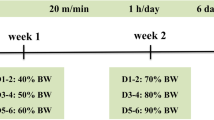Abstract
The physiological importance of the increase in androgen receptors in exercise-induced muscle hypertrophy was investigated in rats. Together with training rat gastrocnemius muscles by electrical stimulation every other day for 2 weeks, male rats were administered the androgen receptor antagonist, oxendolone. The androgen receptor antagonist effectively decreased the wet mass of the prostate, an androgen target organ, and did not significantly affect body mass. The increase in muscle mass induced by electrical stimulation was effectively suppressed by the androgen receptor blockade. The mean degree of muscle hypertrophy in the antagonist-treated group was significantly lower than that in the control group (102.30% vs 107.41%, respectively;P=0.006). This result suggests that the androgen pathway has a significant effect in exercise-induced muscle hypertrophy and emphasizes the importance of the increase in the number of androgen receptors in exercised muscle.
Similar content being viewed by others
References
Govindan MV (1990) Specific region in hormone binding domain is essential for hormone binding and trans-activation by human androgen receptor. Mol Endocrinol 4:417–427
Hickson RC, Galassi TM, Kurowski TT, Daniels DG, Chatterton RT Jr (1983) Skeletal muscle cytosol [3H]methyltrienolone receptor binding and serum androgens: effects of hypertrophy and hormonal state. J Steroid Biochem 19:1705–1712
Inoue K, Yamasaki S, Fushiki T, Kano T, Moritani T, Itoh K, Sugimoto E (1993) Rapid increase in the number of androgen receptors following electrical stimulation of the rat muscle. Eur J Appl Physiol 66:134–140
Krieg M, Smith K, Bartsch W (1978) Demonstration of a specific androgen receptor in rat heart muscle: relationship between binding, metabolism, and tissue levels of androgens. Endocrinology 103:1686–1694
Liao S, Liang T, Fang S, Castaneda E, Shao T-C (1973) Steroid structure and androgenic activity. Specificities involved in the receptor binding and nuclear retention of various androgens. J Biol Chem 248:6154–6162
Michel G, Baulieu EE (1980) Androgen receptor in rat skeletal muscle: characterization and physiological variations. Endocrinology 107:2088–2098
Saartok T, Dahlberg E, Gustafsson J-Å (1984) Relative binding affinity of anabolic-androgenic steroids: comparison of the binding to the androgen receptors in skeletal muscle and in prostate, as well as to sex hormone-binding globulin. Endocrinology 114:2100–2106
Shan L-X, Rodriguez MC, Jänne OA (1990) Regulation of androgen receptor protein and mRNA concentrations by androgens in rat ventral prostate and seminal vesicles and in human hepatoma cells. Mol Endocrinol 4:1636–1646
Sudo K, Yamazaki I, Masuoka M, Nakayama R (1979a) Antiandrogen TSAA-291. IV. Effects of the anti androgen TSAA291 (16beta-ethyl-17-beta-hydroxy-4-oestren-3-one) on the secretion of gonadotrophins. Acta Endocrinol 92 [Suppl 229]:53–66
Sudo K, Yoshida K, Nakayama R (1979b) Anti-androgen TSAA291: VI. Effects of the anti-androgen TSAA-291 and its related compounds on the in vitro formation of 5alpha-DHTreceptor complex in the cytosol of rat ventral prostates. Acta Endocrinol 92 [Suppl 229]:82–99
Takeda H, Chadak G, Mutchinik S, Nakamoto T, Chang C (1990) Immunohistochemical localization of androgen receptors with mono- and polyclonal antibodies to androgen receptors. J Endocrinol 126:17–25
Tollefsen SE, Lajara R, McCusker RH, Clemmons DR, Rotwein P (1989) Insulin-like growth factors (IGF) in muscle development: expression of IGF-I, the IGF-I receptor, and IGF binding protein during myoblast differentiation. J Biol Chem 264:13810–43817
Tremblay RR, Dubé JY, Ho-Kim MA, Lesage R (1977) Determination of rat muscle androgen-receptor complexes with methyltrienolone. Steroids 219:185–195
van Laar JH, Vries JB-d, Legers ND, Trapman J, Brinkmann AO (1990) Androgen receptor heterogeneity and phosphorylation in human LNCaP cells. Biochem Biophys Res Commun 166:193–200
Author information
Authors and Affiliations
Rights and permissions
About this article
Cite this article
Inoue, K., Yamasaki, S., Fushiki, T. et al. Androgen receptor antagonist suppresses exercise-induced hypertrophy of skeletal muscle. Europ. J. Appl. Physiol. 69, 88–91 (1994). https://doi.org/10.1007/BF00867933
Accepted:
Issue Date:
DOI: https://doi.org/10.1007/BF00867933




